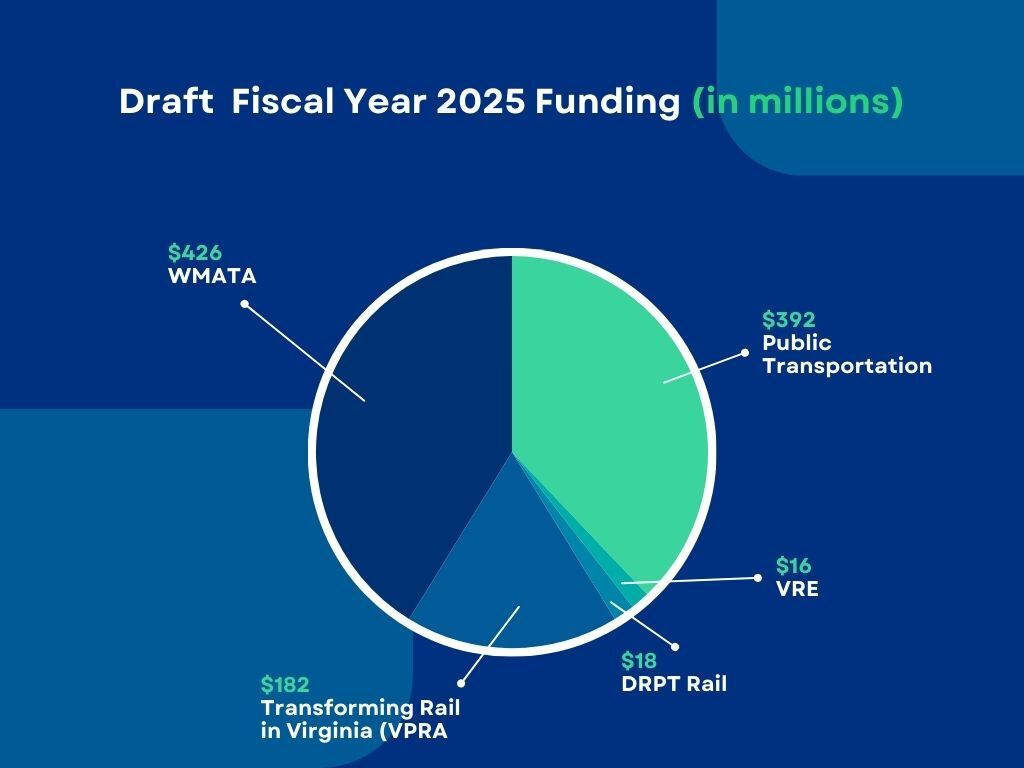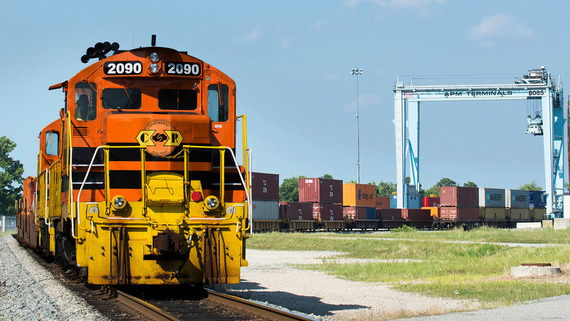|
Welcome to the first edition of DRPT’s Data Stories, and thank you for signing up for this new series! This series will offer engaging data-driven narratives on Virginia’s rail and public transportation. DRPT collects significant amounts of data that, out of context, are hard to digest. Data Stories will use our data to tell the story behind the numbers. Planned data-driven topics include transit ridership and recovery, freight rail’s economic impact, as well as this first Data Story: breaking down the budget and funding for rail and public transit providers across the Commonwealth. |
|
Six-Year Improvement Plan
DRPT’s draft Six-Year Improvement Program (SYIP) for the upcoming fiscal year is live and set to be approved in mid-June, providing just over $1 billion in the upcoming fiscal year to public transportation, freight, and passenger rail, as well as commuter programs, paratransit, and statewide multimodal planning. But what exactly is the Six-Year Improvement Program, and how does it fund rail and public transportation across Virginia?
The SYIP
The Six-Year Improvement Program is the Commonwealth’s funding allocation program for transportation projects across Virginia. The SYIP acts as the budget for transportation priorities across the Commonwealth. Each year, DRPT and our sister organization VDOT develop an update to the SYIP, projecting revenues over the next six state fiscal years and allocations for the upcoming fiscal year. DRPT’s programs receive formula-driven allocations as set forth in Virginia law, while individual projects within each program are grant applications that are scored and approved by the Commonwealth Transportation Board.
The graph below summarizes the allocations provided in the draft SYIP:

|
|
WMATA
The Washington Metropolitan Area Transportation Authority (WMATA), the authority that runs the Metro rail and bus services, will receive $426 million in state funds, coming from a mix of $154.5 million in dedicated funds, $50 million in funds to match federal dollars, and $221 million in formula funds to support WMATA’s high ridership and large operations.
|
|
VRE
The Virginia Railway Express (VRE), the weekday commuter rail service that operates to and from Washington DC along the I-95 and I-66 corridors, will receive approximately $16 million in capital and operating support from state funds. The remainder of their budget is supplemented by fares, regional funds, and fringe funds.
|
|
Rail

|
|
DRPT is dedicated to supporting the freight rail network across the Commonwealth, connecting businesses to the railroads. To that end, DRPT will appropriate $18 million to the Shortline Preservation Fund and Freight Fund to support rail infrastructure investments that expand the Virginia freight rail network, support a state of good repair, and improve reliability, as well as provide statewide rail planning and technical assistance. DRPT’s rail programs support growing businesses, diverting trucks from Virginia’s busiest highways, and connecting materials and goods to regional markets, the national freight network, and international destinations through the Port of Virginia.
While DRPT provides funding for freight rail programs and provides high-level planning for passenger rail, the Virginia Passenger Rail Authority (VPRA) is responsible for turning those high-level passenger rail plans into action. VPRA, a separate entity from DRPT, receives pass-through funds from DRPT to promote, sustain, and enhance passenger rail service across the Commonwealth, as guided by the Transforming Rail in Virginia initiative. For FY 2025, VPRA’s funding totals $182 million.
|
|
Public Transportation funding is an umbrella term covering a long list of state programs and federal pass-through dollars administered by DRPT to support public transportation entities. The largest program is the Making Efficient and Responsible Investments in Transit (MERIT) Program, which provides formula-based support for operating costs and grant-based capital support to public transit providers for minor enhancements, state of good repair, and major expansions to transit providers – this includes expanding vehicle fleets or constructing transit facilities. Additionally, the MERIT program provides funding for “special” programs: demonstration projects, technical assistance to support studies and planning, as well as workforce development programs.
Additional programs under public transit include: the Transit Ridership Incentive Program (TRIP), which provides funding for the purpose of creating more accessible, safe, and regionally significant transit networks; the Commuter Assistance Program (CAP), which is a statewide grant program for programs and projects that are both efficient and effective at increasing ridership on transit, vanpools, and carpools; as well as Paratransit and Human Services grant programs, among others.
|
|
The table below breaks down all of DRPT's public transportation funding by program: |
|
Want to Know More?
The Six-Year Improvement Program is an ongoing process, and a complex one at that. To learn about specific projects funded by the SYIP, visit DRPT’s new Data Portal and select “Six-Year Improvement Program”. To learn more about the SYIP process, visit the Commonwealth Transportation Board’s website.
|
|
|
DRPT’s mission is to connect and improve the quality of life for all Virginians with innovative transportation solutions. The SYIP turns that mission into action, by funding rail and public transportation priorities. With funding from the SYIP, transit agencies across Virginia provide over 10 million trips per month on buses, light rails, and subways. Freight rail programs divert around 14 million trucks from Virginia’s roads and attract hundreds of new jobs.
 Having trouble viewing this email? View it as a Web page. Having trouble viewing this email? View it as a Web page.
|
|
|
|
|